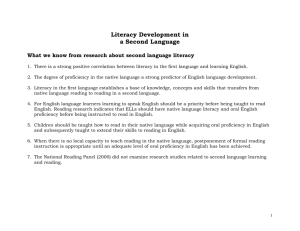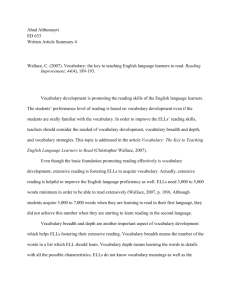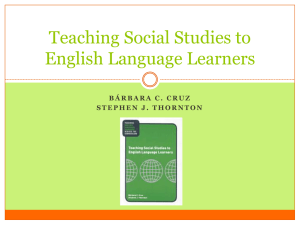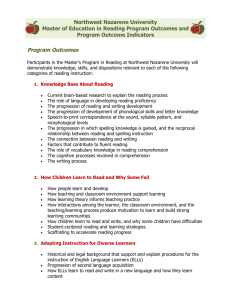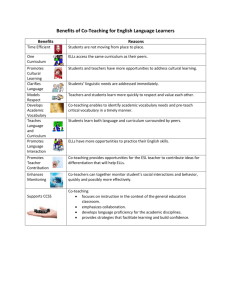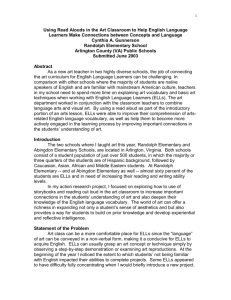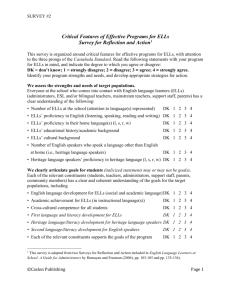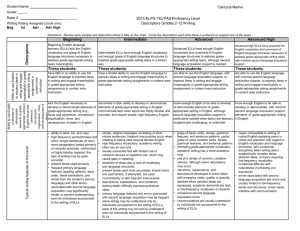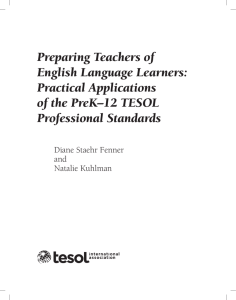ESOL: Applied Linguistics (Online) 60 Points per Certificate 7/12 2
advertisement
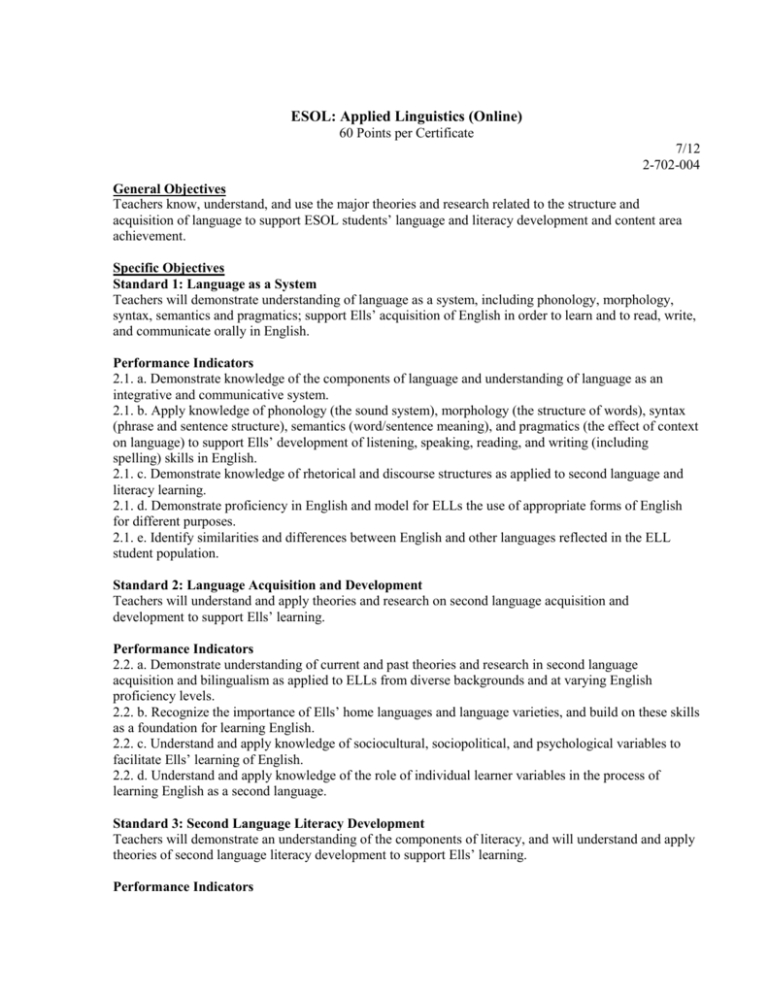
ESOL: Applied Linguistics (Online) 60 Points per Certificate 7/12 2-702-004 General Objectives Teachers know, understand, and use the major theories and research related to the structure and acquisition of language to support ESOL students’ language and literacy development and content area achievement. Specific Objectives Standard 1: Language as a System Teachers will demonstrate understanding of language as a system, including phonology, morphology, syntax, semantics and pragmatics; support Ells’ acquisition of English in order to learn and to read, write, and communicate orally in English. Performance Indicators 2.1. a. Demonstrate knowledge of the components of language and understanding of language as an integrative and communicative system. 2.1. b. Apply knowledge of phonology (the sound system), morphology (the structure of words), syntax (phrase and sentence structure), semantics (word/sentence meaning), and pragmatics (the effect of context on language) to support Ells’ development of listening, speaking, reading, and writing (including spelling) skills in English. 2.1. c. Demonstrate knowledge of rhetorical and discourse structures as applied to second language and literacy learning. 2.1. d. Demonstrate proficiency in English and model for ELLs the use of appropriate forms of English for different purposes. 2.1. e. Identify similarities and differences between English and other languages reflected in the ELL student population. Standard 2: Language Acquisition and Development Teachers will understand and apply theories and research on second language acquisition and development to support Ells’ learning. Performance Indicators 2.2. a. Demonstrate understanding of current and past theories and research in second language acquisition and bilingualism as applied to ELLs from diverse backgrounds and at varying English proficiency levels. 2.2. b. Recognize the importance of Ells’ home languages and language varieties, and build on these skills as a foundation for learning English. 2.2. c. Understand and apply knowledge of sociocultural, sociopolitical, and psychological variables to facilitate Ells’ learning of English. 2.2. d. Understand and apply knowledge of the role of individual learner variables in the process of learning English as a second language. Standard 3: Second Language Literacy Development Teachers will demonstrate an understanding of the components of literacy, and will understand and apply theories of second language literacy development to support Ells’ learning. Performance Indicators 2.3. a. Understand and apply current theories of second language reading and writing development for ELLs from diverse backgrounds and at varying English proficiency levels. 2.3. b. Demonstrate understanding of similarities and differences between L1 (home language) and L2 (second language) literacy development. 2.3. c. Demonstrate understanding of how L1 literacy influences L2 literacy development and apply this to support Ells’ learning. 2.3. d. Understand and apply knowledge of sociocultural, sociopolitical, and psychological variables to facilitate Ells’ L2 literacy development in English. 2.3. e. Understand and apply knowledge of how principles of phonology, morphology, syntax, semantics, and discourse affect L2 reading and writing development. Activities: Aligned to matrix (C), page 18 Participants read course content; participate in formative, interactive activities; view related multimedia clips; visit external websites; and engage in collegial dialogue with the facilitator. These activities will require approximately five to six hours per week. Additionally, participants must successfully demonstrate knowledge gained from course content in a multiple choice quiz exercise and successfully complete nine Reflection/Dialogue Exercises in which they reflect on knowledge gained from course content and apply that knowledge appropriately to English Language Learners. In addition to the multiple choice assessment, Reflection/Dialogue Exercises require application exercises that include a dialogue between a facilitator and the participant, personal evaluation of sources and resources, and lesson plan development. Evaluation of Participants Successful participant completion will be determined by the instructor as demonstrated by one or more of the following: pre and post tests, completed projects or products, demonstration of objectives or competencies, or other method of measurement acceptable to the inservice leader. Activities conducted under this component will be evaluated by participants and inservice leaders to determine 1) the degree to which objectives have been addressed, and 2) the impact of acquired skills on students when implemented in the educational setting. Evaluation of Activity Each participant will complete an online evaluation for this activity through the Santa Rosa Professional Growth System. Learning (Delivery) Methods Activities under this component align with the state-identified delivery method listed below: Electronic, interactive Implementation (Follow-up) Methods Activities under this component align with the state-identified implementation methods listed below. An implementation activity must document the impact of a participant’s acquired skills on students when implemented in the educational setting. Participant Product related to training (may include lesson plans, written reflection, audio/videotape, case study, samples of student work) Electronic – interactive


